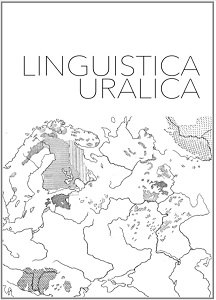N-овые отрицательные элементы пермских языков в контексте финно-угорских реконструкций
Permic Negative Elements with n in the Context of Finno-Ugric Reconstructions
Author(s): Galina FedyunevaSubject(s): Finno-Ugrian studies
Published by: Teaduste Akadeemia Kirjastus
Keywords: inno-Ugric reconstruction; Permic; Ob-Ugric; negation markers; negative pronouns; borrowing;
Summary/Abstract: Among the reliably etymologized markers of negation in a number of modern Finno-Ugric (and Samoyed) languages ń-(n)-elements are found that cannot be unambiguously interpreted. Most of them are the result of reception of the Russian negative particles не and ни, but in the Permic and Ugric languages there are n-negations that are difficult to explain by the Russian influence. These are the element ne̮- ~ no- in the prefix of the Permic negative pronouns, the Komi pronoun ńi-nem, ńem ’nothing’, the Ob-Ugric prefix of negative pronouns ne-/nem- ~ nē-/nēm-, and the Hungarian negation particles ne and nem ’no, not’ having in their composition, unlike Russian borrowings, the non-palatal n. Hypotheses about their origin are based on two opposite points of view, namely (1) they are of Finno-Ugric (Uralic) origin, or (2) in the proto-language there was no n-(ń-)-negation, and these elements appeared in modern languages late and independently. An attempt is made to verify these hypotheses, first of all, from the point of view of the Permic material, which has not yet received detailed coverage, but the proto-Finno-Ugric (Uralic) reconstruction of n-negation directly depends on its reliability. The considered material makes it possible to doubt the presence of a common etymon not only in the Finno-Ugric proto-language, but even in its Finno-Permic or Ugric branches. More promising is the search of intra-linguistic explanations for each individual case, taking into account the powerful external influence of the Russian language. The author’s version of the origin of the Permic negations is given against the background of a commented review of n-markers of negation in those Finno-Ugric languages, which not only borrowed Russian particles, but also formed a full series of negative pronouns under the Russian influence. In turn, this led to a partial restructuring of the Finno-Ugric strategy of negation according to the Russian model. Russian influence undoubtedly took place in the formation of Permic and Ob-Ugric negative pronouns with n-prefixes, at least with regard to their structure and acquisition of negative meaning, but their material source, apparently, were autochthonous intensifying particles.
Journal: Linguistica Uralica
- Issue Year: LVII/2021
- Issue No: 1
- Page Range: 1-23
- Page Count: 23
- Language: Russian

